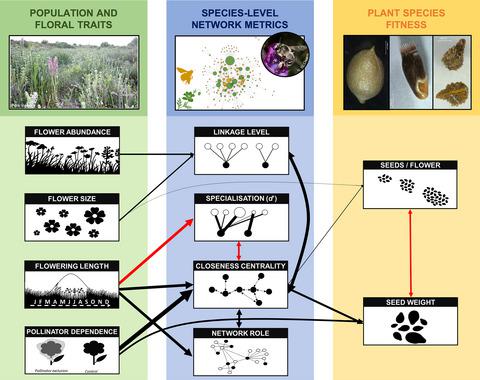Our official English website, www.x-mol.net, welcomes your feedback! (Note: you will need to create a separate account there.)
Linking species‐level network metrics to flower traits and plant fitness
Journal of Ecology ( IF 5.5 ) Pub Date : 2019-11-25 , DOI: 10.1111/1365-2745.13334 Amparo Lázaro 1 , Carmelo Gómez‐Martínez 1 , David Alomar 1 , Miguel A. González‐Estévez 1 , Anna Traveset 1
中文翻译:

将物种一级的网络指标与花性状和植物适应性联系起来
更新日期:2019-11-25
Journal of Ecology ( IF 5.5 ) Pub Date : 2019-11-25 , DOI: 10.1111/1365-2745.13334 Amparo Lázaro 1 , Carmelo Gómez‐Martínez 1 , David Alomar 1 , Miguel A. González‐Estévez 1 , Anna Traveset 1
Affiliation

|
- Theoretical models indicate that the structure of plant–pollinator networks has important implications for the reproduction and survival of species. However, despite the growing information on the mechanisms underlying such a structure, it is still difficult to predict the functional consequences of species’ structural positions in these networks. From the plant perspective, species position and roles in pollination networks might be related to traits describing flower attractiveness, availability and dependence on pollinators. In turn, both network metrics and plant traits might influence plant species fitness.
- During two field seasons, we collected data from the 23 most abundant plant species in a rich coastal community, to evaluate the association between population and floral traits (floral abundance at population level and flowers per individual, flower shape and size, flowering length, nectar volume, pollinator dependence), species‐level network metrics (linkage level, specialization –d ′–, weighted closeness centrality, network roles related to modularity) and plant fitness (seeds/flower, seed weight).
- Flowering length, flower size, flower abundance and pollinator dependence were positively related to greater generalization, as measured by various indices. More abundant species and those with larger flowers showed higher linkage levels (i.e. higher number of pollinator species), whereas longer flowering periods were negatively related to d ′ and positively related to closeness centrality and important roles in the network. Likewise, plants species more dependent on pollinators occupied more central positions in the network. Furthermore, centrality in the networks was significantly associated with plant fitness. Specifically, central species in the network produced more and heavier seeds than the others. However, other plant traits, such as flower size and pollinator dependence had additional direct effects on seed production.
- Synthesis . Our study highlights how population and floral traits define the positions and roles of species structuring the pollination communities. Moreover, the relationships between network metrics and plant reproduction indicate, for the first time, the functional implications of these structural positions at the interspecific level of community assembly.
中文翻译:

将物种一级的网络指标与花性状和植物适应性联系起来
- 理论模型表明,植物-授粉媒介网络的结构对物种的繁殖和生存具有重要意义。然而,尽管有关这种结构的机理的信息越来越多,但仍然很难预测物种在这些网络中的结构位置所产生的功能性后果。从植物的角度来看,物种在授粉网络中的位置和作用可能与描述花朵吸引力,可获得性和对传粉媒介的依赖性的性状有关。反过来,网络指标和植物性状都可能影响植物物种适应性。
- 在两个田间季节中,我们收集了丰富的沿海社区中23种最丰富的植物物种的数据,以评估种群与花卉性状(种群水平上的花卉丰度和每个人的花朵,花朵的形状和大小,花的长度,花蜜)之间的关联。体积,授粉依赖性),物种级网络度量(联动水平,专业化- d ' - ,加权接近中心,与模块化网络角色)和植物适合度(种子/花,种子重量)。
- 如通过各种指标所测量的,开花长度,花大小,花丰度和授粉媒介依赖性与更大的泛化成正相关。丰富的物种和花朵较大的物种表现出较高的连锁水平(即,传粉媒介物种的数量增加),而较长的开花期与d呈负相关。”与紧密度中心关系和网络中的重要角色成正比。同样,更依赖传粉媒介的植物物种在网络中占据了更多的中心位置。此外,网络中的中心性与植物适应性显着相关。具体而言,网络中的中心物种比其他物种产生更多,更重的种子。但是,其他植物性状,例如花的大小和授粉媒介的依赖性,对种子的生产具有额外的直接影响。
- 综合。我们的研究强调了种群和花卉特征如何定义构成授粉群落的物种的位置和作用。此外,网络指标与植物繁殖之间的关系首次表明了这些结构位置在群落装配的种间水平上的功能含义。



























 京公网安备 11010802027423号
京公网安备 11010802027423号